White caterpillars are actually white or pale in color and are the immature stage (Larvae) of diverse moth and butterfly species. Many of these caterpillars usually have elongated bodies with multiple segments, and they can be of different sizes.
Many white caterpillars have a soft and fuzzy appearance (tiny hairs or setae covering their bodies). Some may have markings or patterns on their bodies. The markings may include spots, stripes or other intricate designs which may be used for species recognition
On matters appendages, they have short, stubby antennae on their heads, which they use for sensory perception. They too have multiple pairs of true legs along their body segments, which they use for crawling and holding onto surfaces.
Some white caterpillars have spines, bristles, or projections on their bodies. These structures can serve as a defense mechanism against predators, causing irritation or discomfort upon contact. At the front end of the body, there is a head capsule that houses the caterpillar’s mouthparts, including mandibles for chewing plant material.
White caterpillars primarily feeding on plant leaves. Their feeding habits can range from being generalists to specialists on specific plant species. Just like other caterpillars, these caterpillars too can exhibit different behaviors when feeding, resting or searching for suitable pupation sites.
Many white caterpillars are most often encountered during the late spring, throughout summer to early fall. Many of these caterpillars can produce silk threads from specialized glands located near their mouths. They use these threads to create shelters, spin cocoons, or anchor themselves to surfaces.
Like all caterpillars, they too undergo complete metamorphosis, transitioning through the stages of larva, pupa, and adult. This transformation eventually leads to the emergence of moths or butterflies.
In this article, learn about different types of white caterpillars with their identifying characteristics. Pictures and table of description have been provided so as to make it easy for the reader to identify the species whenever they encounter them in a garden, woodland, forest or park.
Are White Caterpillars Venomous?
Usually, venomous caterpillars possess structures on their bodies or within their skin, that can deliver toxins when touched or disturbed. The work of the toxins is to deter potential predators, such as birds or other insects, from consuming or harming the caterpillar. When a predator attempts to consume or harm a venomous caterpillar, it experiences pain or discomfort, discouraging further attacks.
While white caterpillars are generally harmless, there are many that are venomous. Some cause mild irritation while others are capable of delivering more potent toxins that can cause significant discomfort or even harm to humans.
It is important to exercise caution when encountering any white caterpillar in the wild. Accidental contact with venomous caterpillars like the saddleback caterpillar can lead to painful stings and result to intense pain, itching and localized reactions.
If stung, it’s advisable to wash the affected area with soap and water, apply ice to reduce swelling, and seek medical attention if severe symptoms develop.
Also Read: Different Types of Yellow Caterpillars
Types of White Caterpillars: Identification Guide
Hickory Tussock Moth Caterpillar (Lophocampa caryae)
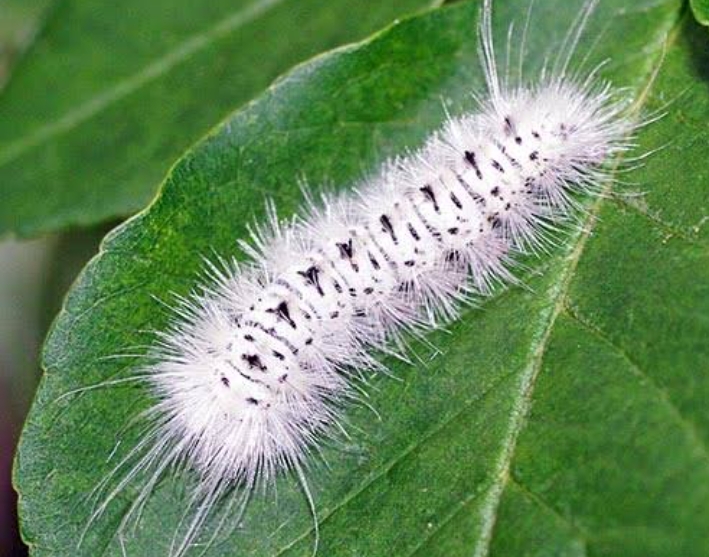
Hickory tussock moth caterpillars are fuzzy, with the body covered in long, white hairs. It also has prominent black spines along its body. Its head is usually black in color. Fully grown caterpillars can grow up to 1.7 inches (4.5 cm). Young caterpillars are white with black spots and white setae (hairs).
The hairs of these caterpillars are known to be irritating and potentially toxic. They can cause skin irritation and allergic reactions in some individuals who come into contact with them.
Mature caterpillars are often encountered on the leave of the host plant, when they crawl around in search of a protected place to spin a cocoon.
Adult moths are tan to light brown and have cream-colored spots that occur in rows; the underwings are cream colored.
These caterpillars are primarily feed on the leaves of different deciduous trees and shrubs, including hickory trees, as well as walnut, ash, oak and other hardwood species.
The species is widely distributed in the eastern half of North America. They can be found from Maine and New Brunswick south to North Carolina, west to Wisconsin and Illinois. They also occur, but are apparently less common, southwest into Texas and Mexico.
Hickory tussock moth caterpillars Facts and Identification
Hickory tussock moth caterpillars can be identified from its distinctive appearance, which features tufts of long, white hairs and black spines.
| Scientific | Lophocampa caryae |
| Family | Erebidae |
| Size | Up to 1.7 inches (4.5 cm) |
| Diet | Deciduous trees and shrubs |
| Predators | Birds, larger spiders, mantises and wasps |
| Occurrence | Early spring to fall |
| Distribution | North America |
Sycamore Tussock Moth (Halysidota harrisii)
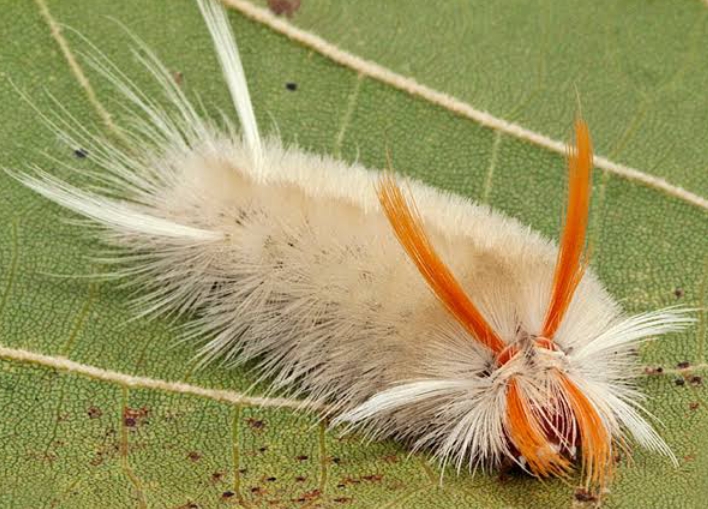
Sycamore Tussock Moth Caterpillars grow to be about 2.5 to 4 cm long. They are covered in white hairs and have orange heads. They exhibit two pairs of long, orange hair-pencils and two pairs of white hair-pencils towards the front of their body. They also exhibit one pair of white hair-pencils near the back of their body.
The long, hair-like setae on these caterpillars can be irritating to the touch. In some cases, they can cause skin irritation in humans.
These caterpillars are known for their gregarious behavior during their early stages of development. They usually cluster together on the undersides of leaves or on tree branches.
Sycamore Tussock Moth Caterpillars feed on a variety of deciduous trees and shrubs, with sycamore trees (Platanus spp.) being one of their preferred hosts. They also consume other trees, such as oaks and maples.
The species was first described by Benjamin Dann Walsh in 1864. It is found in southeastern Canada, the eastern parts of the United States, and northeastern.
Sycamore Tussock Moth Caterpillars Facts and Identification
Dense covering of white long, hair-like setae (hairs) that grow from brown warts on their bodies is the most visible identifying feature of these caterpillars.
| Scientific | Halysidota harrisii |
| Family | Erebidae |
| Size | 2.5 to 4 cm long |
| Diet | Sycamore tree, deciduous trees and shrubs |
| Predators | sparrows, finches, chickadees, and warblers, orb-weavers and crab spiders |
| Occurrence | Early spring to fall |
| Distribution | North America |
Virginian Tiger Moth Caterpillar (Spilosoma virginica)
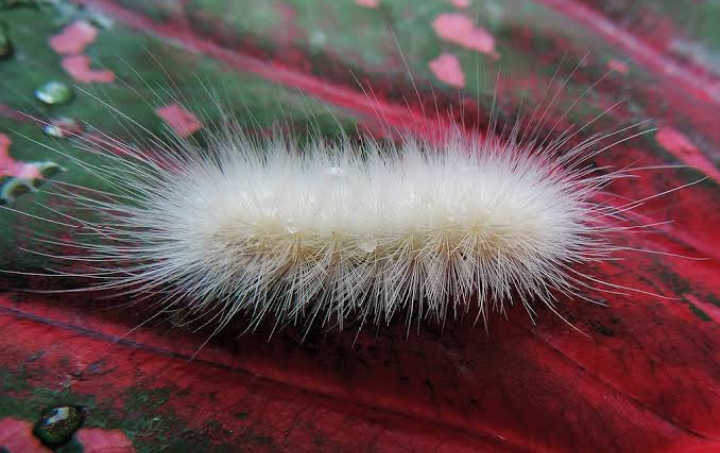
Image Courtesy of Flickr, Credit: Drriss & Marrionn
Virginian Tiger Moth Caterpillars also known as the “yellow woolly bear” have a black body covered in dense, soft white or sometimes in yellowish hairs.
These are not venomous, stinging hairs, but they may cause irritation for some people. As they mature, the hairs become denser and bristlier, covering the body in clustered tufts that have longer hairs in the center of them.
In the late instar stages, Virginian Tiger Moth Caterpillars undergo significant growth and development. By the time they reach their final instar, they can measure anywhere from 2 to 5 centimeters (approximately 0.8 to 2 inches) in length.
These caterpillars are defoliators, skeletonizing the leaves they feed on, but only the late summer batch of caterpillars is plentiful enough to do much damage to crops. This species tends to have two to three life cycles per year, with one hibernating for the winter in temperate climates.
These caterpillars can be found in habitats such as gardens, meadows, and fields, where their food plants are abundant. In the garden you’ll find them on host plants such as dandelions, clover and other herbaceous plants.
Virginian Tiger Moth Caterpillar Facts and Identification
The caterpillars of Virginian tiger moth can be identified by spiky appearance consisting of tufts of creamy-white or tan-white hairs.
| Scientific | Spilosoma virginica |
| Family | Erebidae |
| Size | 2 to 5 centimeters |
| Diet | Leaves, dandelions, clover and other herbaceous plants. |
| Predators | sparrows, finches, chickadees, and warblers, orb-weavers and crab spiders |
| Occurrence | Early spring to fall |
| Distribution | North America |
Fall Webworm Caterpillars (Hyphantria cunea)
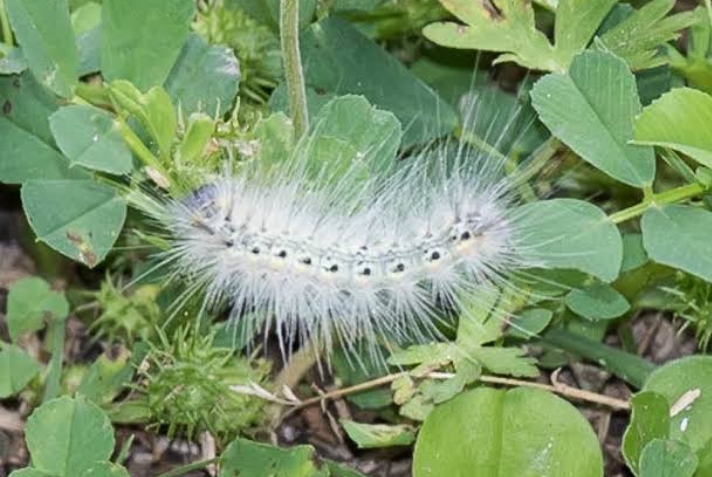
These insects are primarily found in North America, although they have also been spotted in some parts of Europe and Asia.
Fall Webworm caterpillars go through several instars (growth stages) as they mature. They start out as tiny, pale yellow caterpillars with black heads and gradually grow to reach a length of up to 1.5 inches (3.8 cm).
The caterpillars of fall webworm moths differ in the northern and southern parts of their range. In the north, they have a black head, a yellow or green body, and a dark stripe running down their backs. On their sides, they have tufts of whitish hairs that come out of black spots. In the south, they have an orange or red head and a yellow or light brown body. (Bartlett, 2020; “Hyphantria cunea”, 2007).
Fall Webworm caterpillars feed on the leaves of deciduous trees and shrubs. Some of their favorite host plants include walnut, hickory, apple, cherry and various other hardwood trees.
While Fall Webworm caterpillars can defoliate their host plants, they rarely cause significant damage that threatens the overall health of mature trees. Trees typically recover with new growth after defoliation.
The adult fall webworm moth is bright white, with a hairy body. They are nocturnal and not as commonly seen as the caterpillars.
Fall Webworm Caterpillar Facts and Identification
The white fall webworm can be identified by its long, wispy white hairs, two rows of black spots on its back, and a rounded black head.
| Scientific | Hyphantria cunea |
| Family | Erebidae |
| Size | 1.5 inches (3.8 cm). |
| Diet | Walnut, hickory, apple, cherry and various other hardwood trees. |
| Predators | Birds, parasitoid wasps, and other insects. |
| Occurrence | Early spring to fall |
| Distribution | North America |
Also Read: Different Types of Green Caterpillars
Spotted Apatelodes Caterpillar (Apatelodes torrefacta)
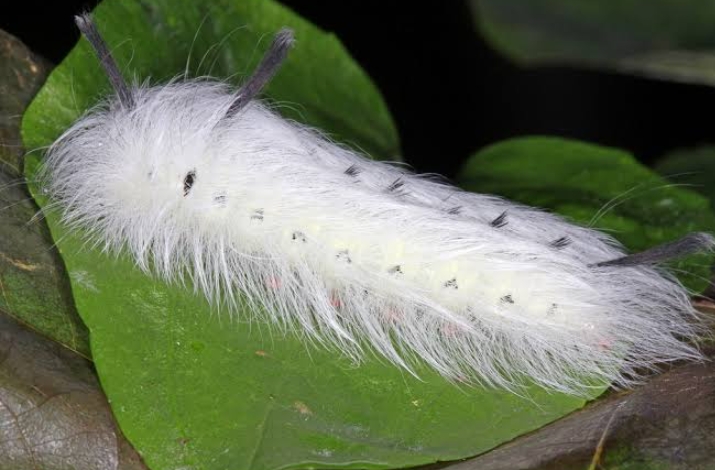
Spotted Apatelodes Caterpillar is a species of the spotted apatelodes moth. The moth species was first described by Smith in 1797. It is found in North America from Maine and southern Ontario to Florida, west to Texas, and north to Wisconsin.
This Caterpillar is easily to identify due to its coat of hair. When they are young, their long and lustrous hairs are a brilliant white. However, as they mature, these hairs undergo a transformation, turning into a dazzling neon yellow.
The caterpillar is relatively large, measuring up to 2 inches (5 cm) in length when fully grown. They are most active during late summer and early fall when they feed and prepare for their pupal stage.
They feed on the leaves of deciduous trees and shrubs, such as oaks, maples and willows. While feeding, they rest on the underside of leaves and use silk threads to secure themselves, preventing accidental falls.
After feeding and growing through several instars (molting stages), the caterpillar eventually pupates. The pupa is typically enclosed in a silk cocoon and can be found attached to a tree branch or other suitable substrate.
Spotted Apatelodes Caterpillar Facts and Identification
Its most identifying feature is its appearance. Its body covered in long, dense hairs (setae) and has identifiable long black tufts on its back and black spots along its sides.
| Scientific | Apatelodes torrefacta |
| Family | Erebidae |
| Size | 2 inches |
| Diet | deciduous trees and shrubs, such as oaks, maples and willows |
| Predators | Birds, parasitoid wasps, and other insects. |
| Occurrence | Early spring to fall |
| Distribution | North America |
White-Marked Tussock (Orgyia leucostigma)
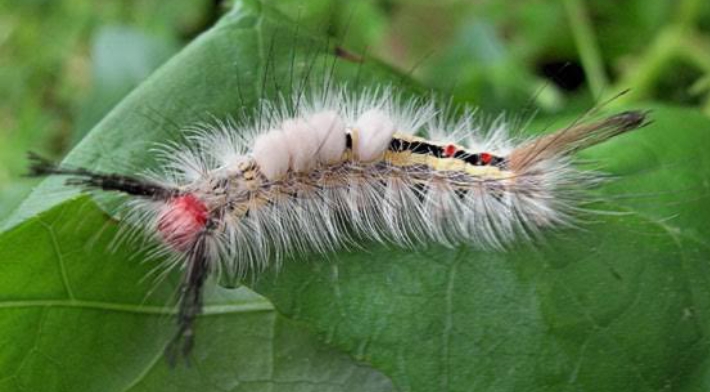
This caterpillar has a mix of colors, including black, white and orange. The head is bright red and the body has yellow or white stripes, with a black stripe along the middle of the back. White toothbrush-like tufts stand out from the back, and a gray-brown hair pencil is at the hind end.
The hairs are not attached to venom glands like the hairs and bristles on more dangerous caterpillars. However, they can puncture the skin causing hives and skin rashes on individuals who are highly sensitive to the irritation. Adult caterpillars measure between 1/2 inch (13 mm) to 1 inch (25 mm) in length.
Early instar caterpillars feed as leaf skeletonizers and older caterpillars consume the entire leaf leaving behind the larger veins. High populations have been known to completely defoliate small trees in less than a week.
Some of the more common plant hosts include apple, basswood, elm, maple, oak, pear, plums, poplars, redbud, rose, sycamore, walnut, and willow.
White-marked Tussock caterpillar facts and identification
It has four fluffy white tufts on its back, and tufts of pencil hairs around its body.
| Scientific | Orgyia leucostigma |
| Family | Erebidae |
| Size | 25-35 mm |
| Diet | Basswood, elm, maple, oak, pear, plums, poplars, redbud, rose, sycamore, walnut, and willow. |
| Predators | Birds, parasitoid wasps, and other insects. |
| Occurrence | Early spring to fall |
| Distribution | North America |
Domestic Silk Moth Caterpillar (Bombyx mori)
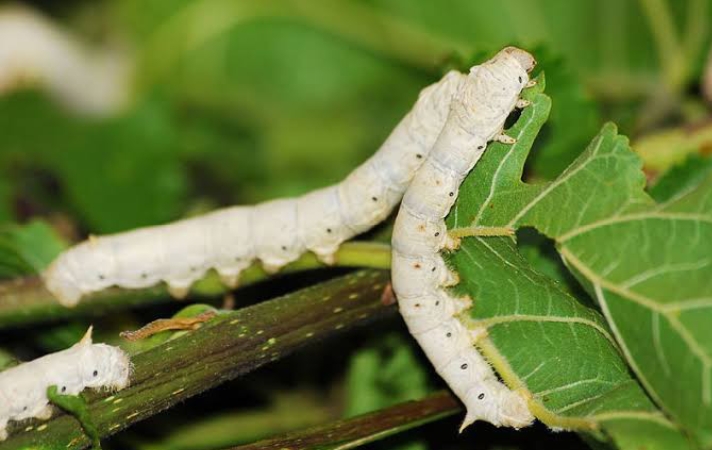
The Domestic Silk Moth caterpillar (Bombyx mori) is a is the caterpillar of the Silk Moth. The domestic silk moth is not found in the wild as it has been bred and domesticated for silk production over thousands of years.
It originated in China and has since been widely cultivated across the world especially in regions with a suitable climate for mulberry trees (the caterpillar’s primary food source).
After molting, the caterpillars emerge with a white, naked, and somewhat horned appearance on their backs. These “horns” are actually small projections known as tubercles.
In other words, this white, smooth-bodied caterpillars have a tiny horn on their back, a single black dot on each segment, and yellowish-white feet. The white worm-like bugs grow 1.5” (40 mm) long.
While the caterpillars prefer white mulberry leaves, they are not monophagous, meaning they can also consume leaves from other species of Morus (mulberry) and even some other plants in the Moraceae family, like the Osage orange.
The Domestic Silk Moth has a total wingspan in the range of 1.18”-1.97” (30-50 mm). The body of the Domestic Silk Moth has an overall length between .67”-1.14” (17-29 mm).
Domestic Silk Moth caterpillar facts and identification
These caterpillars are white, naked, and somewhat horned appearance on their backs.
| Scientific | Bombyx mori |
| Family | Bombycidae |
| Size | 25-40 mm |
| Diet | Mulberry |
| Predators | Birds, parasitoid wasps, and other insects. |
| Occurrence | Early spring to fall |
| Distribution | North America |
Catalpa Sphinx Caterpillar (Ceratomia catalpa)
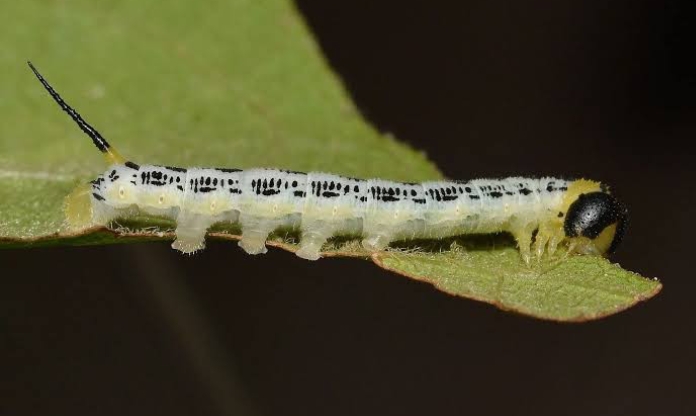
Catalpa sphinx caterpillars are native to the eastern United States and can be found wherever catalpa trees occur from New Hampshire and Nebraska south to the Florida and Texas. The species was first described by Jean Baptiste Boisduval in 1875.
These caterpillars have a lime-green body with prominent black and white markings. They have a pair of horn-like projections on their posterior end, which can resemble the eyes of a snake. There’s also a “pale” phase in some individuals where the black striping may be less prevalent or even missing entirely. In these cases, a shade of white or light yellow replaces the black markings.
As the name suggests, Catalpa Sphinx Caterpillars primarily feed on the leaves of Catalpa trees, such as the Southern Catalpa (Catalpa bignonioides) and the Northern Catalpa (Catalpa speciosa). They are sometimes referred to as “Catalpa worms” because of their association with these trees.
These caterpillars grow to an average length of about 5 cm (2.0 inches) when fully developed. After reaching their full size, the caterpillars prepare for pupation. This process takes place in a sheltered location.
Catalpa Sphinx Caterpillars go through several molting stages as they grow. Each molt results in a larger and more colorful caterpillar. The horn-like projections on their posterior also grow longer with each instar.
In some regions, Catalpa Sphinx Caterpillars are used as bait for fishing, particularly for catching catfish. They are also sometimes raised and sold for this purpose.
Catalpa Sphinx Caterpillar Facts and Identification
They start off pale and become yellowish-green with dark black markings. The most prominent feature black and white stripes running along their back, which is dotted with black spots.
| Scientific | Ceratomia catalpa |
| Family | Sphingidae |
| Size | 30-50 mm |
| Diet | Catalpa trees |
| Predators | Birds, parasitoid wasps, and other insects. |
| Occurrence | Early spring to fall |
| Distribution | North America |
Virginia Ctenucha Caterpillar(Ctenucha virginica)
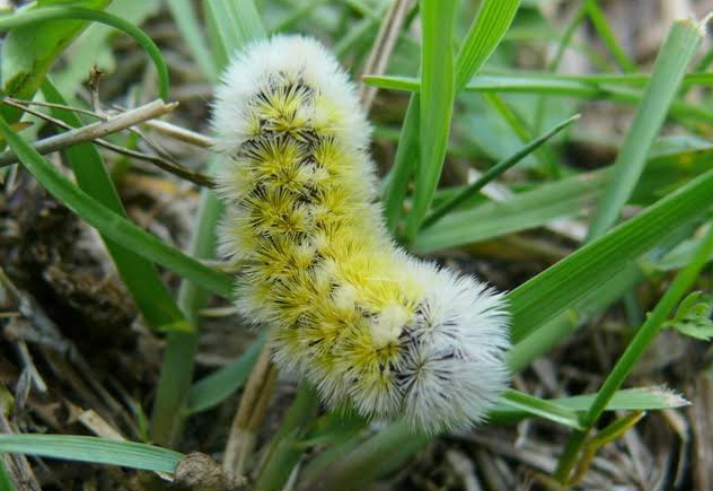
The Virginia Ctenucha Caterpillar is beautiful in appearance. It has a slender body covered in dense, velvety black bristles. It can easy be identified by its whitish or yellowish bands running horizontally across its body. At the front end, you’ll find a pair of black, curved horns that resemble antennae.
Virginia Ctenucha Caterpillars are solitary feeders, usually found munching on grasses and other low-lying plants. Their choice of habitat is usually influenced by the presence of their preferred host plants, such as various grasses and sedges.
It is endemic to eastern North America, from Newfoundland south to Virginia. It is usually found in the open habitats such as meadows, grasslands, prairies and fields.
Once fully grown (1 to 1.5 inches (2.5 to 3.8 cm) in length, the caterpillar pupates by forming a cocoon, attached to a plant or the ground. Inside the cocoon, it undergoes a transformation into an adult moth.
Virginia Ctenucha Caterpillar and Facts and Identification
These caterpillars have a striking appearance with a jet-black or dark brown body covered in dense, long, and shaggy hairs (setae). There are two bands of two bright orange bands that encircle their body.
| Scientific | Ctenucha virginica |
| Family | Erebidae |
| Size | 1 to 1.5 inches (2.5 to 3.8 cm) |
| Diet | Grasses and sages |
| Predators | sparrows, warblers, and flycatchers, lizards and certain snakes |
| Occurrence | Early spring to fall |
| Distribution | North America |
Hieroglyphic Moth Caterpillar (Diphthera festiva)
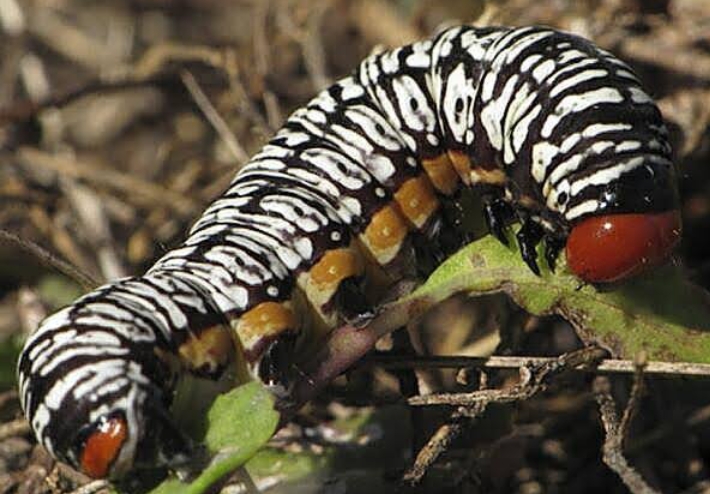
The caterpillar of Diphthera festiva has a unique appearance. It features a bold pattern of markings that closely resemble ancient Egyptian hieroglyphs, with intricate lines, shapes, and symbols running along its body. The markings are black and white in color around the plump body. The adult can be between 2 to 3 inches (5 to 7.5 cm) when fully grown.
Hieroglyphic Moth Caterpillars eat herbaceous plants like wildflowers and other vegetation. They also feed on the leaves of deciduous trees such as oak, maple and cherry.
When disturbed or threatened, the caterpillar can exhibit defensive behaviors such as thrashing its body or regurgitating a green fluid, which may deter potential predators.
Diphthera festiva can be found in parts of North and South America, like the United States, Mexico and Central and South America. In some regions, they are used as bait for fishing, particularly for catching catfish.
Like many caterpillar species, they undergo several molts as they grow, shedding their old exoskeleton to accommodate their increasing size.
Hieroglyphic Moth Caterpillar Facts and identification
Cylindrical or plump body with black and white bands
| Scientific | Diphthera festiva |
| Family | Nolidae |
| Size | 2 to 3 inches (5 to 7.5 cm) |
| Diet | Wild flowers, oak, maple and cherry |
| Predators | Ladybugs, lacewings, warblers, and cuckoos, shrews and rodents. |
| Occurrence | Early spring to fall |
| Distribution | North America |
Rubber Tree Caterpillar (Lymire edwardsii)
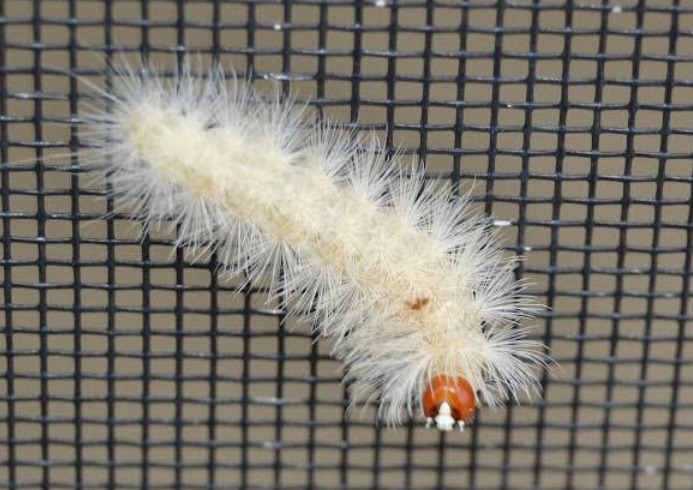
These caterpillars are found in parts of South and Southeast Asia, including countries like India, Sri Lanka, Thailand, and Malaysia. They are also known by other common names such as “Rubber Plant Caterpillar” or “Rubber Tree Tussock Moth Caterpillar.” It was described by Augustus Radcliffe Grote in 1881. It is found in southern Florida, United States.
The caterpillars have a bright yellow or orange body, covered with tufts of white setae (bristle-like structures). When fully grown, they can reach lengths of around 5 centimeters (2 inches). It also has an identifiable crimson red and white head.
They feed on different plant species, but as their name suggests, they have a preference for rubber trees (Hevea brasiliensis) and related plants. They can easily be found on rubber tree plantations, as well as in natural forested areas.
Rubber Tree Caterpillar Facts and identification
They have a fuzzy and soft appearance with a bright yellow or orange body, covered with tufts of white hairs.
| Scientific | Lymire edwardsii |
| Family | Erebidae |
| Size | 5 centimeters (2 inches) |
| Diet | Rubber trees |
| Predators | Ladybugs, lacewings, orb-weaving spider, assassin bugs, mantises, and certain beetles, |
| Occurrence | Early spring to fall |
| Distribution | North America |
Dogwood Sawfly Caterpillar (Macremphytus testaceus)
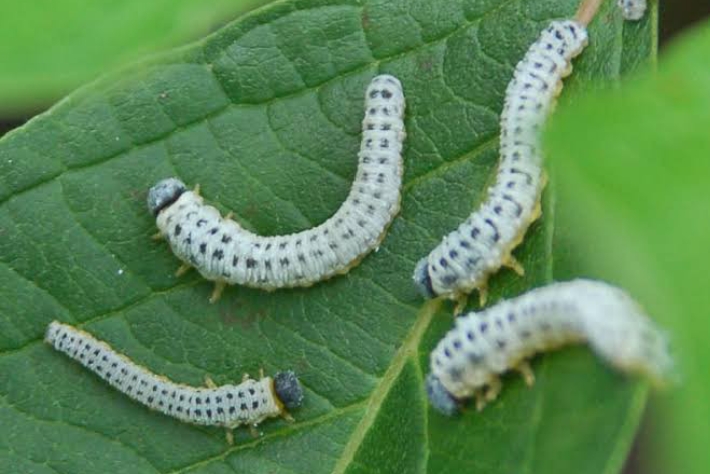
Macremphytus testaceus is a large dogwood sawfly. Sawflies are not true flies but are instead related to bees and wasps. The Dogwood Sawfly Caterpillar is primarily found in North America, in the United States and southern Canada from the east coast to the Great Plains.
The caterpillar has a white fluffy body with yellow legs. The fuzzy-looking white larvae are often seen curled up underneath dogwood foliage. At the front end of its body, the caterpillar has a well-defined head capsule, which is often darker in color compared to the rest of the body.
The caterpillars can reach a length of about 2.5 centimeters (1 inch) when fully grown. They feed primarily on the leaves of various species of dogwood trees (Cornus spp.). They chew through the leaves, consuming the soft tissues and leaving behind the veins. When present in large numbers, they can defoliate the entire plant.
Like many caterpillars, Dogwood Sawfly Caterpillars exhibit gregarious behavior during their early stages, feeding together in groups. As they mature, they may become more solitary.
These white worm-like caterpillars are active in mid to late summer. The creamy-white caterpillars overwinter in rotted wood, and the sawflies emerge the following spring. The adult sawflies are wasp-like insects with membranous wings.
Dogwood Sawfly Caterpillar Facts and identification
It is identified by its white, waxy coating in its second instar.
| Scientific | Macremphytus testaceus |
| Family | Tenthredinidae |
| Size | 1 inch (2.5 cm) in length |
| Diet | Dogwood trees |
| Predators | Shrews and rodents, ladybugs (lady beetles), lacewings and assassin bugs. |
| Occurrence | Early spring to fall |
| Distribution | North America |
Figwort Sawfly Caterpillar (Tenthredo scrophulariae)
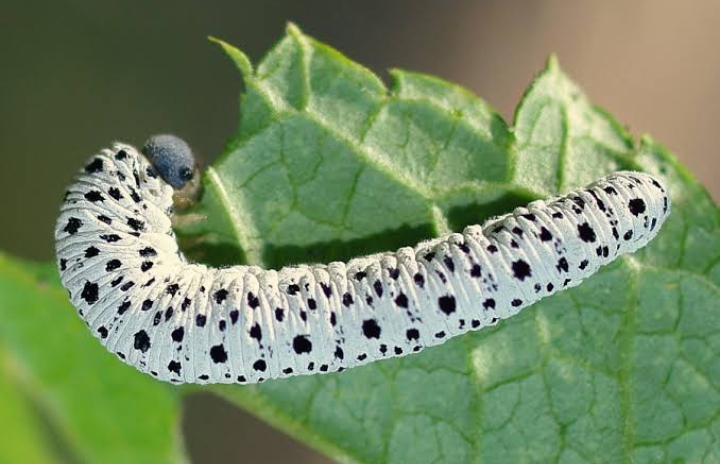
The Figwort Sawfly Caterpillar measures around 1 to 1.5 inches (2.5 to 3.8 centimeters) in length. They are creamy-white with lots of black spots dorsally and a blackish head capsule. They primarily feed on snapdragons, mullein (Verbascum spp.) and figworts (Scrophularia spp.).
Their feeding activity can cause damage to host plants, but it is generally not considered a significant threat to the overall health of plant populations.
After reaching maturity, the caterpillar pupates in a cocoon or protected location. Eventually, it emerges as an adult sawfly, which is a flying insect resembling a wasp.
Dogwood Sawfly Caterpillar Facts and identification
They generally have a white body with black spots.
| Scientific | Tenthredo scrophulariae |
| Family | Tenthredinidae |
| Size | 1.5 inches (2.5 to 3.8 centimeters) in length. |
| Diet | Mullein and figworts |
| Predators | Shrews and rodents, ladybugs (lady beetles), lacewings and assassin bugs. |
| Occurrence | Early spring to fall |
| Distribution | North America |
Laugher Caterpillar (Charadra deridens)

A Laugher Moth caterpillar in Washington Co., Maryland (9/14/2020). Photo by Mark Etheridge
The Laugher Caterpillar grows to about 1-2 inches (2.5-5 cm) in length when fully grown. Its squishy body has a cylindrical shape and is covered with long wispy white hairs. The head of the Laugher Caterpillar is small compared to its body. It is brown or dark-colored and may have a series of fine lines or markings.
The most notable feature of this Caterpillar that has earned it its colloquial name, the “Laugher” caterpillar, is the pattern on its dorsal side. This pattern consists of:
- A dark central band that resembles a smiling mouth or grin.
- Two pale, curved lines extending from the sides of the “mouth,” which resemble cheeks.
- Two small dark spots above the “mouth,” which resemble eyes.
This pattern creates the illusion of a smiling face and is quite remarkable in the insect world.
Laugher Caterpillars are active from June to October. They consume the leaves of deciduous trees and shrubs. It can be found in Ontario, Quebec, New Brunswick, Nova Scotia, Prince Edward Island, British Columbia, Saskatchewan and Manitoba in Canada, through most of the United States except the south-western states.
Laugher Caterpillar Facts and identification
Squishy white bodies covered in wispy long white hairs
| Scientific | Charadra deridens |
| Family | Noctuidae |
| Size | 38mm to 48mm (1.49″ to 1.88″) |
| Diet | Shrubs and deciduous trees |
| Predators | Songbirds, woodpeckers, orb-weavers, jumping spiders, hawks and owls. |
| Occurrence | Early spring to fall |
| Distribution | North America |
Planthopper Parasite Moth Caterpillar (Fulgoraecia exigua)

This is one the strangest caterpillars. It has a stout and stark white body. It is covered with a short hairy fuzz that looks like cotton or some type of fungus. Unlike other caterpillars, the planthopper parasite caterpillar prefers to eat small insects. It often sucks the fluids out of planthoppers for its nutrition.
The life cycle begins with the female moth laying eggs near the host plant or planthopper nymph habitat. Once the eggs hatch, the caterpillars emerge and begin to feed on planthopper nymphs. They have specialized mouthparts for piercing and sucking fluids from their prey. This stage lasts for several weeks as the caterpillars grow and molt through multiple instars.
After reaching maturity, the caterpillar pupates. It constructs a silk cocoon or sheltered pupation site, where it undergoes metamorphosis into the adult moth.
The adult Planthopper Parasite Moth is quite different in appearance. It has a wingspan of around 2 to 3 centimeters. The forewings of the moth are usually gray or brown with various markings, while the hindwings are paler.
It is found in North America, where it has been recorded from New Jersey and Pennsylvania to central Florida, west to Missouri, Texas, New Mexico, Arizona and California.
Planthopper Parasite Moth Caterpillar Facts and identification
The caterpillar is stout and has a stark white body covered with a short, hairy fuzz that resembles cotton or fungus.
| Scientific | (Fulgoraecia exigua) |
| Family | Epipyropidae |
| Size | Approximately 1 to 2 centimeters in length |
| Diet | planthopper nymph and other small insects |
| Predators | Songbirds, woodpeckers, orb-weavers, jumping spiders, hawks and owls. |
| Occurrence | Early spring to fall |
| Distribution | North America |
Mullein Moth Caterpillar (Cucullia verbasci)
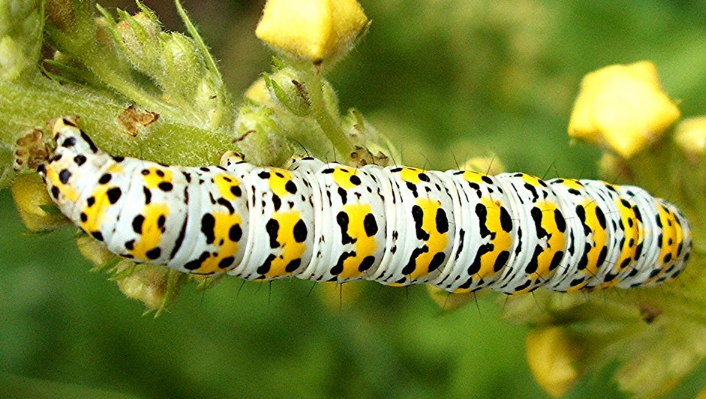
The Mullein Moth Caterpillar can be found in parts of North America, Europe and Asia. It is named after its preferred host plant, the mullein (Verbascum spp.), a group of tall, flowering plants with woolly leaves.
When fully grown they are almost 50mm in length with a mixture of black and yellow markings on a pale bluey grey/whitish body. Their size and unique color make them easy to spot among the foliage. Gardeners frequently come across the caterpillars during the months of June and July.
Once the eggs hatch, the Mullein Moth Caterpillar emerges. It spends its entire larval stage feeding on mullein leaves. They are voracious eaters, often consuming large portions of the leaves during the day as well as at night. They also eat the leaves of other plants like figworts and buddleia.
After several weeks of feeding and growing, the caterpillar enters the pupal stage. It spins a silk cocoon among the mullein leaves or nearby vegetation. The cocoon may overwinter several times before the adult moth emerges. The adult Moth is generally brown with a wingspan of around 1 to 1.5 inches (2.5 to 3.8 centimeters).
Mullein Moth Caterpillar Facts and identification
They have white rounded bodies with bright yellow patches and lots of small black dots. The caterpillars are particularly fond of mullein plants.
| Scientific | Cucullia verbasci |
| Family | Noctuidae |
| Size | Approximately 2.5 to 5 centimeters in length |
| Diet | Mullein, figworts and buddleia. |
| Predators | sparrows, warblers, finches, ladybugs (ladybird beetles), lacewings and predatory wasps |
| Occurrence | June to July |
| Distribution | North America, Europe and Asia |